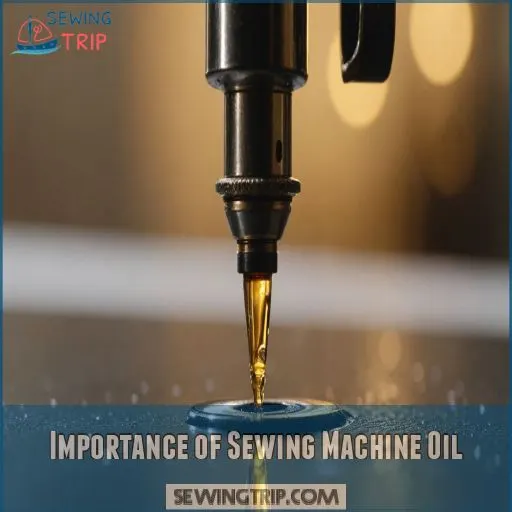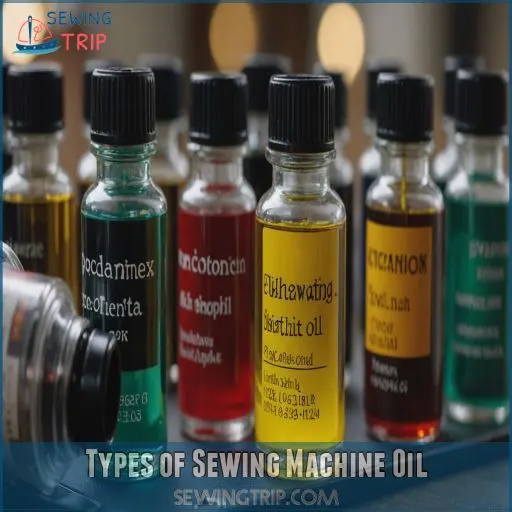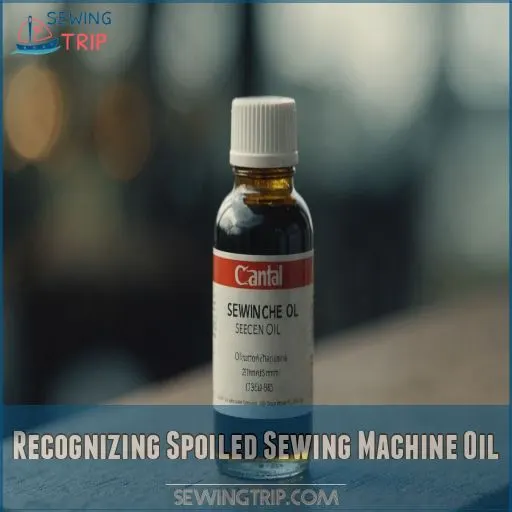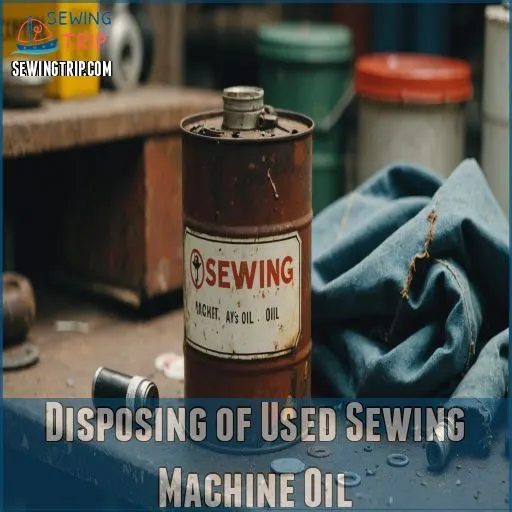This site is supported by our readers. We may earn a commission, at no cost to you, if you purchase through links.

Old oil can mess up your sewing game faster than a cat chasing your thread. It makes the parts stick, and it can also ruin the stitch quality and damage your machine.
Keep your oil fresh by storing it in a cool, dry place. And remember, check the oil’s color and texture regularly.
A smooth, clear oil is your machine’s best friend. Ever wondered about choosing the right type of sewing machine oil?
Table Of Contents
- Key Takeaways
- Importance of Sewing Machine Oil
- Types of Sewing Machine Oil
- Recognizing Spoiled Sewing Machine Oil
- Effects of Using Old or Incorrect Oil
- Proper Storage and Maintenance of Oil
- Choosing the Right Sewing Machine Oil
- Using and Applying Sewing Machine Oil
- Disposing of Used Sewing Machine Oil
- Signs and Frequency of Oiling
- Frequently Asked Questions (FAQs)
- Conclusion
Key Takeaways
- You’ll want to toss your sewing machine oil if it looks cloudy, smells funny, or turns into sludge. It’s like finding curdled milk in your fridge – time to say goodbye.
- Keeping your machine well-oiled is like giving it a spa day; it prevents parts from sticking and keeps your stitches as smooth as a jazz tune.
- Store your sewing machine oil away from sunlight and moisture. Think of it as wine – it needs a cool, dark place to stay fresh and be ready for action.
- Using old or the wrong oil is like using pancake syrup in your car; it gums things up and shortens your machine’s lifespan faster than a cat darting after a laser pointer.
Importance of Sewing Machine Oil
You probably don’t think about it much, but sewing machine oil is like a magic potion that keeps the gears turning smoothly.
It helps reduce friction, prevents overheating, and keeps dust from gumming up your stitches, all of which keep your sewing machine purring like a contented cat for years to come.
Reducing Friction and Wear
Ever noticed how a well-oiled machine hums like a happy bee? Sewing machine oil is your secret weapon for friction reduction and wear prevention.
To keep your machine running smoothly for years to come, follow these three tips:
- Opt for high-quality oil with correct oil viscosity.
- Regularly apply it to the right spots.
- Avoid oil degradation by using fresh oil.
Preventing Overheating and Dust Buildup
Imagine this: your sewing machine runs like a dream, until it overheats!
Regularly oiling your sewing machine is essential for dust prevention and overheating solutions.
A little oil keeps parts moving smoothly and the cooling systems happy, ensuring air filtration does its job.
Just remember, you can prevent sewing machine oil deterioration by checking its clarity and shelf life, which helps in oil deterioration prevention.
Consistent Stitch Quality
You’ve kept your machine from overheating, but how about stitch consistency?
Sewing machine oil is the secret sauce. With regular maintenance, you’ll achieve flawless stitches, avoiding the dreaded bird’s nest of tangled thread.
Proper oiling smooths over needle condition, stabilizes thread tension, and caters to every fabric type—like an orchestra conductor, sewing machine oil leads to a symphony of perfect stitches.
Extending Machine Lifespan
Keeping your stitches crisp does more than beautify your projects; it extends your machine’s lifespan. Regular oiling keeps those gears purring like a well-fed kitten, ensuring longevity. Remember, the right routine can mean the difference between a vintage heirloom and a metallic nightmare.
- Preventative Care: Preserves internal components.
- Proper Usage: Reduces risk of damage.
- Troubleshooting Issues: Spots problems early.
Types of Sewing Machine Oil
When choosing sewing machine oil, you’ve got options.
Mineral oil is the most common and affordable choice, while synthetic oil offers better protection for plastic parts.
Knowing the differences between these types can help you keep your machine running smoothly.
Mineral Oil Properties
For mineral oil for your sewing machine, you want the right viscosity—think Goldilocks, not too thick, not too thin.
It’s affordable and safe, but be sure to store it well to maintain its purity and longevity.
And remember, don’t just pour it down the drain when you’re done; proper oil disposal is key.
Synthetic Oil Advantages
While mineral oil holds its ground, synthetic oil stands tall with its benefits.
It boasts excellent longevity and makes sure it’s compatible with plastic parts, safeguarding your machine.
You’ll find it cost-effective, and its performance benefits are like having a secret weapon against wear and tear.
Plus, its lower environmental impact makes it a green choice for sewing machine lubrication.
Natural Oil Characteristics
You’ve experienced synthetic oils’ advantages, now let’s explore natural oils. They offer eco-friendly benefits, and choosing the right one makes a difference.
- Natural oil viscosity affects how smoothly it spreads.
- Environmental impact is lower, making it a green choice.
- Jojoba oil benefits include reduced friction.
- Consider silicone oil properties and ester oil applications to fit your sewing needs.
Recognizing Spoiled Sewing Machine Oil
Ever found an old bottle of sewing machine oil in a drawer and wondered if it’s still good?
Knowing how to spot spoiled oil—like noticing a strange smell or sludge at the bottom—can save your machine from a messy disaster.
Change in Color or Consistency
Imagine your sewing machine oil turning from clear to murky—it’s like an unexpected dye job! Oil discoloration signals trouble.
Keep an eye on its viscosity and thickness. If it’s sticky, thick, or colored, it’s time for new oil. Don’t risk sewing machine oiling mistakes.
Here’s a quick cheat sheet:
| Change | Indicator | Action Needed |
|---|---|---|
| Color Shift | Darkening | Replace Oil |
| Viscosity | Thickening | Replace Oil |
| Texture | Stickiness | Replace Oil |
Cloudy Appearance or Eerie Odor
Noticing a cloudy look or a spooky scent in your sewing machine oil? These could be signs of oil degradation or that your oil storage tips need revisiting.
Here’s a quick checklist:
- Cloudy appearance
- Eerie, off-putting odor
- Reduced oil lifespan
- Need for proper disposal methods
- Consider natural alternatives or bike lubricant
Trust your nose and eyes—they’re good oil detectives!
Sedimentation or Sludge Formation
Occasionally, you may notice a concerning sign – sedimentation or sludge forming in your sewing machine oil. This indicates the oil has deteriorated and needs to be replaced. Check the oil’s color, texture, and odor regularly to catch any changes.
A clear, smooth oil is ideal; cloudy or thick oil should be replaced.
| Symptom | Meaning |
|---|---|
| Dark or cloudy color | Oil has expired |
| Unpleasant odor | Oil has gone bad |
| Sedimentation in bottle | Oil is contaminated |
| Thick, sticky consistency | Oil has broken down |
| Varnish buildup | Oil has oxidized |
Effects of Using Old or Incorrect Oil
Using old or incorrect sewing machine oil can turn your sewing day into a disaster.
It’s like trying to run your car on salad dressing.
You’ll face jammed parts and poor stitch quality that shorten your machine’s life quicker than you’d expect due to using the wrong oil, which is like trying to run your car on salad dressing.
Poor Stitch Quality and Machine Damage
Misusing old or incorrect sewing machine oil can turn your sewing projects into a tangled mess. You’ll face poor stitch quality, leading to frustration.
- Worn needles
- Tension issues
- Thread problems
- Increased cleaning
- Possible machine damage
Parts Sticking and Reduced Performance
Your machine’s skipping stitches might escalate to stuck parts if you’re not careful with oil choices. Old or incorrect oil can send performance down the drain. Think about it like putting pancake syrup in your car engine—messy and ineffective!
Troubleshoot by identifying oil type and consider these lubricant alternatives:
| Symptom | Solution |
|---|---|
| Stuck Parts | Replace with proper oil |
| Reduced Sewing | Check lubricant frequency |
| Odd Noises | Explore oil alternatives |
Prevent future sticking with regular maintenance.
Shortened Machine Lifespan
Machine wear and poor maintenance can quickly shorten your sewing machine’s lifespan. Use old or incorrect oil, and you’ll face issues faster than a cat on a hot tin roof.
Avoid these pitfalls:
- Over-oiling: Can cause parts to gum up.
- Neglecting cleaning: Increases friction and wear.
- Incorrect oil: Leads to damage and costly repairs.
Proper Storage and Maintenance of Oil
Don’t let your sewing machine oil go bad before you even use it.
Keep it fresh by storing it away from sunlight and in a cool, dry place.
Because nobody wants to turn their crafting dreams into a slippery mess.
Avoiding Direct Sunlight and Extreme Cold
Imagine leaving your sewing machine oil outside on a sunny beach or in a chilly freezer. Just as you’d age rapidly in such conditions, oil suffers too!
To prevent oil degradation, stash it in a cool drawer, away from sunlight and extreme cold.
Remember, a little care in storage saves a heap of trouble later with a cool drawer.
Protecting From Condensation and Water
To protect your sewing machine oil from condensation and water, store it in a cool, dry place away from direct sunlight.
Consider these tips:
- Keep oil containers tightly sealed to prevent air exposure.
- Use a dehumidifier or silica gel packets to absorb excess moisture in the storage area.
- Monitor oil regularly for any signs of contamination, such as cloudiness or sedimentation.
Storing in Undamaged Containers
After shielding your oil from water, make sure it rests in undamaged containers.
This simple step keeps container integrity intact, preventing contamination risk and oil degradation.
Ever spilled milk? Worse yet, spilled oil!
Solid storage practices save your investment from turning rancid.
Remember, recycling options exist for old oil—but keeping it fresh? Now that’s pure mastery at work!
Choosing the Right Sewing Machine Oil
When choosing the right sewing machine oil, don’t just grab whatever’s handy in the kitchen—olive oil isn’t your machine’s friend.
Picking the right type, whether mineral or synthetic, helps keep your sewing machine in tip-top shape, so it sings through fabric without a hitch.
Considering Machine Needs and Materials
Every sewing machine has its quirks, and choosing the right oil is really important to keeping it happy.
Consider machine materials and oil compatibility, especially if you’ve got plastic parts. Modern machines, in particular, often require minimal lubrication, and some models are even oilless, eliminating the need for regular oiling altogether, so following manufacturer recommendations is key.
Pick an oil with suitable viscosity for your machine’s lubrication needs. You’ve got this—being mindful of these details means smoother sewing sessions without those irksome squeaks and jams!
Selecting Mineral or Synthetic Oil
Choosing between mineral and synthetic oil involves weighing cost comparison and machine compatibility.
Synthetic oils might win the environmental impact and longevity race but can cost a pretty penny.
Mineral oil, affordable and reliable, is like your trusty old bicycle.
Consider oil viscosity for smooth sewing. A wise choice keeps those stitches crisp and your machine purring longer.
Avoiding Household Oils
You might think reaching for household oils like cooking oil is a smart shortcut, but they can spell disaster for your sewing machine.
These oils can gum up and attract dust, leading to sewing machine damage and a shorter lifespan.
Stick to sewing-specific oils to make sure oil safety, reduce environmental impact, and keep those stitches smooth.
Using and Applying Sewing Machine Oil
Keeping your sewing machine running smoothly is simpler than you might think—just follow the manual, add a tiny drop of oil at each point, and clean first to avoid lint monsters.
A well-oiled machine is like a happy friend that rarely complains, which can be achieved by remembering one key point: a well-oiled machine.
Following the Machine Manual’s Oiling Points
Your sewing machine manual knows best when it comes to oiling points. Follow its guidance to a tee – it’ll point out the specific spots that need a drop or two of that clear, light sewing machine oil. Don’t forget to clean the machine first, then turn the handwheel to distribute the oil evenly.
- Unplug the machine for safety.
- Check the manual for oiling instructions.
- Apply oil to the recommended parts.
- Wipe off any excess oil.
Using a Tiny Drop of Oil at Each Point
Think of your sewing machine like a squeaky door hinge—a tiny drop of oil at each point works wonders.
It’s important to avoid over-oiling, so use oil application tools for precise oil placement.
Trust me, maintaining a correct oil amount and consistent oiling frequency keeps your machine purring like a content cat, not a rusty gate! (Source).
Cleaning the Machine Before Oiling
Now that you’ve mastered oiling precision, let’s focus on cleaning the machine.
Start by using cleaning tools for lint removal and dust prevention. Brush cleaning helps dislodge stubborn fuzz while removing threads keeps the gears happy.
Remember, a clean machine runs smoothly but also sings like a sewing symphony, free from the drama of dirt when following a proper machine cleaning tutorial
!
Let’s focus on cleaning the machine.
Disposing of Used Sewing Machine Oil
Getting rid of old sewing machine oil isn’t as easy as tossing it out with last night’s leftovers.
You’ll need to recycle it properly or soak it up with kitty litter.
Before checking with local rules to make sure it’s disposed of safely.
Recycling Used Oil Safely
Before ditching used sewing machine oil, let’s recycle it safely. Follow local regulations and consider oil recycling programs to minimize environmental impact.
Explore these alternative uses:
- Use it as a rust preventive for tools.
- Lubricate squeaky hinges or other gadgets.
- Consider donating to community workshops needing lubricant.
A stitch in time saves nine—avoid polluting!
Absorbing Oil With Material
Let’s turn oil spills into no biggie! Grab some absorbent materials like old rags or sawdust for an environmentally friendly cleanup.
| Material | Oil Cleanup Method | Emotion Evoked |
|---|---|---|
| Old Towels | Sop up oil | Relieved and ready |
| Sawdust | Spread and absorb | Eco-friendly champ |
| Kitty Litter | Sprinkle and scoop | Feel like a boss |
| Newspaper Bits | Cover and soak | Ingenious genius |
| Baking Soda | Sprinkle and scrub | Clean and content |
Safe disposal is key!
Proper Disposal and Local Regulations
After soaking up that old oil, it’s time to think about proper disposal to avoid environmental impact. When disposing of bad sewing machine oil, consider recycling used oil to minimize waste.
Additionally, never dump oil directly into landfills or sewers, as this can cause pollution. Look for local regulations to find oil recycling centers that accept hazardous waste.
They’ll make sure safe handling of used sewing machine oil. It’s not just trash—it’s a small step in reducing our footprint. Safe disposal guidelines make a world of difference!
Signs and Frequency of Oiling
Wondering how often to oil your sewing machine?
Don’t worry, it’s not rocket science. Keep an eye out for signs like strange noises or sticky parts – that’s your cue to give it a quick oiling.
Most experts recommend oiling daily for frequent users and every eight hours for casual sewers.
How Often to Oil a Sewing Machine
You’ve tidied up your old sewing machine oil, but how often should you oil the machine itself?
Consider your machine’s age and usage frequency.
If you’re sewing daily, a weekly oiling might be best. Weekend warriors can stretch it to monthly.
Just listen for noise levels and check stitch quality, as they’re indicators of when to grab that oil bottle.
Signs of a Sewing Machine Needing Oil
Ever hear your sewing machine sounding like it’s auditioning for a Broadway musical?
That’s your cue for oiling! Watch for noisy grindings, skipping stitches, or sticky moving parts—clear signs your machine craves attention.
Use the right oil to maintain stitch quality and monitor oil color and consistency to make sure you have smooth sewing adventures.
Humor your machine; it’ll thank you! (Source)
Daily or Regular Oiling Recommendations
Amidst sewing adventures, remember your machine’s need for oiling love. Regular oiling boosts performance and extends its lifespan.
Notice:
- Squeaky parts: Time for a drop.
- Frequent use: Oil daily or every few sessions.
- Type matters: Use quality oil.
Keep it humming smoothly like a well-oiled sewing maestro.
Frequently Asked Questions (FAQs)
Does sewing machine oil go bad?
Sewing machine oil can turn bad after about five years.
If it looks cloudy, smells wrong, or feels sticky, it’s time to toss it.
Keep it in a cool, dark place to prolong its life.
Does a sewing machine need to be oiled?
Regularly oiling your sewing machine is key to keeping it running smoothly and quietly.
Just follow the manufacturer’s instructions and use the right sewing machine oil – it’ll make a world of difference.
Why does a sewing machine need to be oiled?
To keep your sewing machine humming smoothly, oil it regularly.
This lubrication prevents metal parts from grinding or seizing, which can turn your sewing time into a noisy mess and reduce the machine’s lifespan .
How often should a sewing machine be oiled?
Think of oiling your sewing machine like giving it a spa day.
For heavy use, oil it weekly; for weekend crafting, monthly.
Light users can wait six months.
Follow your manual for best results.
Does machine oil go bad?
Machine oil can last a long time, but if it turns yellow, thick, or smells funny, it’s time to toss it.
Clear, light oil works best, so don’t let it gunk up your machine.
Why is my sewing machine oil turning yellow?
Your sewing machine oil’s turning yellow because it’s likely expired.
Switch to fresh, clear oil to keep your machine singing like a well-tuned piano.
How to know if a sewing machine needs oil?
About 70% of sewing machine issues are from lack of oil.
If it makes strange noises or feels sluggish, it’s probably time for oil.
Check your manual for specific spots to add a few drops.
Can I use WD-40 instead of sewing machine oil?
Using WD-40 as sewing machine oil is not a good idea.
It strips lubricants, leaving metal parts dry and potentially damaged.
Use it as a solvent to clean old grease but stick to sewing machine oil for lubrication.
Can sewing machine oil be used in cold climates?
Don’t let the cold weather freeze up your sewing machine!
Switch to a thinner oil like 0W to keep things running smoothly.
Just be sure to check your manual for the right grade.
Is yellowing of sewing machine oil dangerous?
Yellowing of sewing machine oil isn’t dangerous; it happens due to organic matter in the oil.
It still works fine (Source), think of it like an aging wine, just a little change in color.
What alternatives exist if sewing machine oil isnt available?
Stuck without sewing machine oil?
Relax; Tri-Flow oil and mineral oil can pinch-hit safely, just like a trusty friend stepping in to help.
But always remember, genuine sewing machine oil is your machine’s best buddy.
How does altitude affect oiling frequency?
Oiling frequency might change a bit with altitude due to variations in temperature and air pressure.
Keep your sewing machine happy by checking its lubrication regularly, especially if you’re sewing at different elevations.
Is different oil needed for industrial machines?
You’ll want a specific oil for industrial machines.
It’s like choosing the right fuel for a car—it matters for performance.
Industrial oils reduce friction and increase lifespan.
Always check the manual for compatibility with your machine.
Conclusion
Think of sewing machine oil as the lifeline of your machine, ensuring smooth operation and longevity.
Yes, sewing machine oil does get old, and using spoiled oil is like running on flat tires—it slows you down and causes damage.
Keep your machine purring by checking the oil’s freshness, choosing the right type, and storing it properly.
Regularly oiling your machine maintains stitch quality and prevents wear, helping you stitch happily ever after.
Your machine will thank you!















